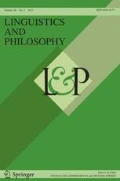References
Barwise, J. and R. Cooper: 1981, ‘Generalized Quantifiers in Natural Language’,Linguistics and Philosophy 4, 159–219.
Chierchia, G.: 1992, ‘Anaphora and Dynamic Binding’,Linguistics and Philosophy 15, 111–183.
Cooper, R.: 1979, ‘The Interpretation of Pronouns’, in F. Heny and H. Schnelle (eds.),Syntax and Semantics 10, Academic Press, New York, pp. 61–92.
Cooper, R.: 1983,Quantification and Syntactic Theory, Reidel, Dordrecht.
Evans, G.: 1980, ‘Pronouns’,Linguistic Inquiry 11, 337–362.
Groenendijk, J. and M. Stokhof: 1990, ‘Dynamic Montague Grammar’, in L. Kalman and L. Polos (eds.),Papers from the Second Symposium on Logic and Language, Akademiai Kiado, Budapest, pp. 3–48.
Groenendijk, J. and M. Stokhof: 1991, ‘Dynamic Predicate Logic’,Linguistics and Philosophy 14, 39–100.
Heim, I.: 1982,The Semantics of Definite and Indefinite Noun Phrases, unpublished Ph.D dissertation, University of Massachusetts, Amherst, MA.
Heim, I.: 1990, ‘E-type Pronouns and Donkey Anaphora’,Linguistics and Philosophy 13, 137–177.
Kadmon, N.: 1990, ‘Uniqueness’,Linguistics and Philosophy 13, 273–324.
Kamp, H.: 1981, ‘A Theory of Truth and Semantic Interpretation’ in J. Groenendijk, T. Janssen, and M. Stokhof (eds.),Formal Methods in the Study of Language, Mathematical Center, Amsterdam, pp. 277–322.
Kanazawa, M.: 1994, ‘Weak vs. Strong Readings of Donkey Sentences and Monotonicity Inference in a Dynamic Setting’,Linguistics and Philosophy,17.
Landman, F.: 1989a, ‘Groups, I’,Linguistics and Philosophy 12, 559–605.
Landman, F.: 1989b, ‘Groups, II’,Linguistics and Philosophy 12, 723–744.
Lappin, S.: 1989, ‘Donkey Pronouns Unbound’,Theoretical Linguistics 15, 263–286.
Lewis, D.: 1975, ‘Adverbs of Quantification’, in E. Keenan (ed.),Formal Semantics of Natural Language, Cambridge University Press, Cambridge, pp. 3–15.
Link, G.: 1983, ‘The Logical Analysis of Plurals and Mass Terms: A Lattice-Theoretical Approach’, in R. Baeuerle et al. (eds.),Meaning, Use, and Interpretation, de Gruyter, Berlin, pp. 302–323.
Link, G.: 1987, ‘Generalized Quantifiers and Plurals’, in Peter Gärdenfors (ed.),Generalized Quantifiers, Reidel, Dordrecht, pp. 151–180.
Loebner, S.: 1987, ‘Natural Language and Generalized Quantifier Theory’, in Peter Gärdenfors (ed.),Gerneralized Quantifiers, Reidel, Dordrecht, pp. 181–201.
Neale, S.: 1990,Descriptions, MIT Press, Cambridge, MA.
Pelletier, J. and L. Schubert: 1989, ‘Generically Speaking’, in G. Chierchia, B. H. Partee, and R. Turner (eds.),Properties, Types, and Meaning, Vol. 2, Kluwer, Dordrecht.
Author information
Authors and Affiliations
Additional information
Earlier versions of this paper were presented at the University of Pennsylvania Computational Linguistics Forum in April, 1993, and the ASL/LSA Conference on Logic and Linguistics at the Ohio State University, Columbus, Ohio, in August, 1993. We are grateful to the participants of these forums for their comments and criticisms. We would like to thank Gennaro Chierchia, Irene Heim, and Andy Kehler for helpful discussion of some of the ideas proposed in this paper. Finally, we wish to thank two anonymous referees for useful criticisms of an earlier draft. Part of the research for this paper was done in the summer of 1992. when the first author was a Research Staff Member at the IBM T.J. Watson Research Center in Hawthorne, NY and visited the Computer Science Department of the Israel Institute of Technology-Haifa Technion. This visit was funded by a joint grant from the Haifa Technion and the University of Haifa as part of the Formal Models of Cognitive Concepts project. The second author's work was partially supported by a grant from the fund for the promotion of research at the Haifa Technion, and by a grant from the Ministry of Science of Israel.
Rights and permissions
About this article
Cite this article
Lappin, S., Francez, N. E-type pronouns, i-sums, and donkey anaphora. Linguist Philos 17, 391–428 (1994). https://doi.org/10.1007/BF00985574
Issue Date:
DOI: https://doi.org/10.1007/BF00985574

